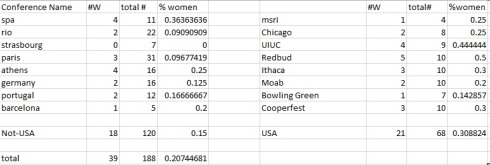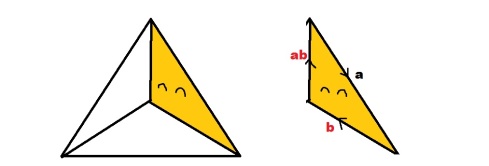A few months ago I was one of two Distinguished Graduate Speakers at this awesome conference, Underrepresented Students in Topology and Algebra Research Symposium (USTARS). The conference started in 2011, when a bunch of advanced grad students and postdocs (I don’t think anyone on the committee was a professor yet) decided that there needed to be a place for underrepresented students to see other people like them doing the math they did. And now they’re all professors and still organizing this traveling conference! So many people of color! So many women! So many homosexual people! (Not so many trans people…) So many first-generation college students! So great! Too many slides! (I pretty actively hate slide talks unless there are pictures that are impossible to make on a chalk board.)

Credit: Erik Insko for this picture of me giving a talk at USTARS 2016!
Anyway, I wanted to blog about some math I saw there, based on a talk by Chassidy Bozeman, a grad student at Iowa State and a fellow EDGE-r. The talk is from a paper that resulted from her graduate research course, which Iowa offers to intermediate grad students and gets them started on research (hence the eight authors on that paper). I thought it was fun and approachable! And I have one crumpled page of two-month old notes, so we’ll see how this goes.
First, let’s remember what a graph is: a collection of vertices (dots) and edges (lines between dots). A graph is simple if there’s at most one edge between any two vertices, and if no vertex has an edge to itself (aka a loop). A loop graph allows loops, but still no multiple edges.

Left is a simple graph, right is a loop graph
You can associate an infinite family of symmetric matrices to a loop graph. These square matrices will have the number of vertices of the graph as the number of columns and rows, and the entry will be 0 if and only if there is no edge between the corresponding vertices i and j in the graph. The rest of the entries will just be real nonzero numbers. This infinite family is useful for defining the minimum rank of a loop graph: it’s the minimum rank over all of this infinite family of matrices. The rank of a matrix is a measure of how large it is. For definition by example,
has rank 1, and
has rank 2.
So the goal of Chassidy’s talk was to characterize all loop graphs whose minimum rank is the full size of the graph. A couple more definitions before the theorem: a generalized cycle is a subgraph whose connected components are either a loop, a single edge, or a cycle. It’s spanning if it touches every vertex in the graph. Spanning generalized cycles don’t always exist!

Components of a generalized cycle: loop, edge, cycle

No spanning generalized cycle, womp womp
Theorem: A loop graph has minimum rank equal to its size if and only if there exists a unique spanning generalized cycle.
Quick nonexample: here’s a picture of a loop graph that has more than one spanning generalized cycle, so from the theorem we know it doesn’t have minimum rank four.

This is theorem 3.1 in their paper. It’s also comically the end of my notes on this talk. Here are a few facts they use to prove the theorem:
- If H is an induced subgraph of G (that means the vertices of H are a subset of the vertices of G, and its edges are all the edges that appear in G within that subset), then it minimum rank is bounded above by the minimum rank of G. Succinctly,
.
- If G is a disjoint union of a bunch of connected components, the its minimum rank is the sum of the minimum ranks of those components.
.
Here’s a picture of my notes! Read the actual paper if you want to know more!


















 Anyways, this is not about me, this is about
Anyways, this is not about me, this is about 








![By Accelerometer (Own work) [CC BY-SA 3.0 (http://creativecommons.org/licenses/by-sa/3.0)], via Wikimedia Commons](https://upload.wikimedia.org/wikipedia/commons/e/e4/Borromean_Seifert_surface.png)

